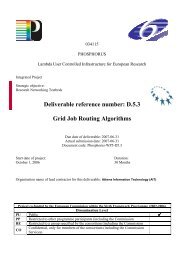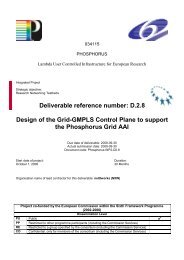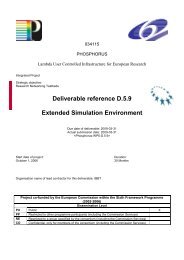D7.1.1: Phosphorus presentation
D7.1.1: Phosphorus presentation
D7.1.1: Phosphorus presentation
- No tags were found...
You also want an ePaper? Increase the reach of your titles
YUMPU automatically turns print PDFs into web optimized ePapers that Google loves.
PHOSPHORUSLambda User Controlled Infrastructurefor European Research
PHOSPHORUS OVERVIEW Instrument: Integrated Project under FP6 Activity: IST-2005-2.5.6 – research networking test-beds Project duration 30 months Project started 01 October 2006 Project budget 6 868 969 euro (5 125 098 euro ECcontribution) Project resources 814 personmonths http://www.ist-phosphorus.eu
PHOSPHORUS PROJECT European and Global alliance of partners to developadvanced solution of application-level middleware andunderlying management and control plane technologies Project Vision and Mission• The project will address some of the key technical challenges inenabling on-demand end-to-end network services across multipleheterogenous domains• In the <strong>Phosphorus</strong>' implementation the underlying network will betreated as first class Grid resource• <strong>Phosphorus</strong> will demonstrate solutions and functionalities across atest-bed involving European NRENs, GÈANT2, Cross Border DarkFibre and GLIF
MEMBERS OF THE CONSORTIUMNRENs & RON: CESNET Poznan Supercomputing andNetworking Center SURFnet MCNCManufacturers:SMEs: ADVA Optical Networking Hitachi Europe Ltd. NORTEL NextworksUniversities and ResearchInstitutions: Communication Research Centre Fraunhofer-Gesellschaft Fundació I2CAT Forschungszentrum Jülich Interdisciplinair instituut voor BreedBandTechnologieResearch Academic ComputerTechnology InstituteResearch and Education Society inInformation Technology SARA Computing and NetworkingServices University of Bonn University of Amsterdam University of Essex University of Wales Swansea
PHOSPHORUS PARTICIPANTS
PROJECT KEY FEATURES 1/3 Demonstrate on demand service delivery across multidomain/multi-vendorresearch network test-beds on aEuropean and Worldwide scale. The test-bed will include:• EU NRENs: SURFnet, CESNET, PIONIER as well national test-beds(VIOLA, OptiCAT, UKLight)• GN2, GLIF and Cross Border Dark Fibre connectivity infrastructure• GMPLS, UCLP, DRAC and ARGON control and management planes• Multi-vendor equipment environment (ADVA, HITACHI, NORTEL,Vendor’s equipment in the participating NREN infrastructure)
PROJECT KEY FEATURES 2/3Develop integration between application middleware and transportnetworks, based on three planes:• Service plane:– Middleware extensions and APIs to expose network and Grid resources and make reservations of thoseresources– Policy mechanisms (AAA) for networks participating in a global hybrid network infrastructure, allowing bothnetwork resource owners and applications to have a stake in the decision to allocate specific network resources• Network Resource Provisioning plane:– Adaptation of existing Network Resource Provisioning Systems (NRPS) to support the framework of the project– Implementation of interfaces between different NRPS to allow multi-domain interoperability with <strong>Phosphorus</strong>’resource reservation system• Control plane:– Enhancements of the GMPLS Control Plane (G²MPLS) to provide optical network resources as first-class Gridresource– Interworking of GMPLS-controlled network domains with NRPS-based domains, i.e. interoperability betweenG 2 MPLS and UCLP, DRAC and ARGON
PROJECT KEY FEATURES 3/3 Studies to investigate and evaluate further the projectoutcomes :• Study resource management and job scheduling algorithmsincorporating network-awareness, constraint based routing andadvance reservation techniques• Develop a simulation environment, supporting the <strong>Phosphorus</strong> networkscenario Disseminate the project experience and outcomes, toolkitsand middleware to NRENs and their users, such asSupercomputing centres
PHOSPHORUS NETWORK SCENARIOApplication 1 Application 2 Application nApplicationsServiceplane 1Serviceplane 2Serviceplane nNREN+vendor 1ControlplaneNREN+vendor 2NRPSNREN+vendor nNRPS+ControlplaneEquipmenttransport+DataλEquipmenttransport+DataλEquipmenttransport+data
PHOSPHORUS ARCHITECTUREThe different domains of the<strong>Phosphorus</strong>' test-bed will have: Grid middleware UNICORE asa reference pointAAA policies Three types of NRPS: UCLP DRAC ARGONTwo “flavours” of GMPLS standard (Ph. 1) Grid-enabled (Ph. 2)
THE PHOSPHORUS DEVELOPMENT CHAINPhase I: Grid App. Grid Middle WareNRPS OUNI GMPLS Optical NetworkGrid ResourcePhase II: Grid App. Grid Middle Ware NPRS G-OUNI G²MPLS Optical Network Grid ResourceThis solution will be finalized progressively during the project:• starting from existing Grid applications, middleware, NRPS & NCP, we will develop an e2e usercontrolledenvironment over heterogeneous infrastructure deploying two mutually unaware layers(i.e. Grid and network)• G²MPLS Control Plane is the evolution of the previous approach, making the NCP Grid-awarePHOSPHORUS will provide GMPLS and G²MPLS Control Plane prototypes to beattached upon the commercial equipments at NRENs:• An important role of the equipment vendors into the consortium and with vendors involved withparticipating NRENs is to facilitate interfacing with their equipment• This is a practical solution for an experimental proof-of-concept RN test-bed• No direct commercial product dependency but useful feedback for their commercial deployment
OVERLAY MECHANISM FOR GRID - PH. 1 Assumptions:• The Grid broker discovery and selection process handle only traditionalcompute and storage resources• The connection between the Grid user and the optical network is implementedthrough the Optical User Network Interface (OUNI). Actions:• The Grid client submits its service request to the Grid middleware, whichprocesses and forwards it to the Grid broker.• The Grid broker discovers available services and selects the Grid cluster toperform the request.• The Grid middleware forwards the request to the light-path provisioning device• The connection between the Grid user and the Grid cluster through lightpath setup in the optical transport layer• The service request is sent to the Grid cluster though the selected light-path,the request is performed and the response is returned by the Grid cluster.
THE OVERLAY MODELUserIP NetworkData IntensiveApplicationData/QueryGridmiddlewareGridBrokerData/QueryGrid InfoSystemData/QueryData/QueryGrid ResourceDATALightpathprovisioning APIDATAPhysical layeradaptationOUNI (standardised)GMPLS Control Plane (traditional)Optical TransportNetworkPhysical layeradaptationOXC 1OXC 2
INTEGRATED MECHANISM FOR GRID - PH. 2The integrated approach: Network resources is treated as “first class” Grid resource• The same way as storage and processing resourceNew approach to control and network architectures• GMPLS signalling which can be extended for Grid resources (G 2 MPLS):– Extension to GMPLS signalling is feasible to accommodate the Gridinformation in exchanging messages
A NEW MECHANISM FOR GRID RESOURCE BROKERING Assumptions:• A direct connection between the Grid (applications and resources) and the optical network is donethrough the Grid Optical User Network Interface (G-OUNI), which is implemented on a Grid edgedevice.• The Grid info system is integrated with the GMPLS control (G 2 MPLS) which contains informationregarding the optical network resources. As a result, the discovery and selection process manages“traditional” compute, storage, etc. resources/services and optical network resources.• The Grid edge device initiates and performs the co-ordinated establishment of the chosen optical pathand the Grid cluster. Actions:• The Grid client submits its service request to Grid middleware, which processes it and forwards it tothe Grid edge device.• The Grid edge device requests connection between the Grid client and a Grid cluster through theOptical Control Plane• The Optical Control Plane performs discovery of Grid resources coupled together with optical networkresources and returns the results with their associated costs to the Grid broker• The Grid broker chooses the most suitable resource and a light-path is set-up using GMPLS signaling
THE INTEGRATED MODELUserData IntensiveApplicationGOUNI (D)APIGOUNI (S)GOUNI (S)APIGrid ResourceGOUNI (D)DATAPhysicallayeradaptationGA-APIGrid ResourceInfo. SystemOpticalresourceGridResourceSchedulersOpticalresourceGR-APIConstraintBasedRoutingOpticalresourceAPION-enabled GridMiddlewareDATAPhysicallayeradaptationExtended GMPLS (Grid-enabled)OXC 1OXC 2
INITIAL APPLICATIONS, PART 1 WISDOM - Wide In Silica Docking On Malaria:• large scale molecular docking on malaria to compute million of compounds withdifferent software and parameter settings (in silico experimentation)• The goal within <strong>Phosphorus</strong> is the deployment of a CPU-intensive applicationgenerating large data flows to test the Grid infrastructure, compute and networkservices KoDaVis – Distributed visualisation (FZJ, PSNC, UESSEX)• The main objective in <strong>Phosphorus</strong> is to adapt KoDaVis to the <strong>Phosphorus</strong>'environment to make scheduled synchronous reservations of itsresources via the UNICORE middleware:– Compute capacity on the data server and the visualisation clients– Allocate network bandwidth and QoS between server and clients
INITIAL APPLICATIONS, PART 2TOPS – Technology for Optical Pixel Streaming (FHG, SARA)• Streaming of Ultra High Resolution Data Sets over Lambda Networks• Adapt the idea of video streaming: constant stream of pixels from renderer to display• Use lossy protocols for long distance connectivity: High performance TCP hard to achieve,UDP performance trivial• Light weight application – scalable bandwidth usageDDSS - Distributed Data Storage System (PSNC, HEL, FZJ, FHG, UESSEX)• GridFTP - a high performance, secure, reliable data transfer protocol optimized for highbandwidthwide-area IP networks.• Backup/archive copies with TSM (Tivoli Storage Manager) over the test network• possible scenarios of usage– data gathering or data distributing– backups of large medical data volumes (bandwidth demanding) from one or many clients– from one or many clients
MULTI-DOMAIN TESTBED
PHOSPHORUS WORK PACKAGESWP1 WP0Project ManagementWP2 WP5WP4: Authentication, Authorization and Accounting (AAA)-Supporting Network Scenario Studies andSystem SpecificationsWP3WP6WP1: NRPSWP2:Enhancements toGMPLS for Grid ServicesWP3: Middleware Optical Router and ApplicationsWP6: Test-bed Final and DemonstratorDemonstration ActivitiesWP7WP7: Dissemination, Exploitation Contribution and Dissemination to standards, Liaisons
WP 1: NETWORK RESOURCE PROVISIONINGSYSTEMS (NRPS) FOR GRID NETWORK SERVICES1. Definition of NRPS and GMPLS control plane boundaries.3. Development of interfaces:• For NRPS interoperability.• Between different NRPS’s and the standard GMPLS control plane.• Between different NRPS’s and the Grid enabled GMPLS ( G 2 MPLS)control plane. (Preliminar prototype by the end of First Phase)4. Implementation of the Network Service Plane. Demonstrate interoperability betweenNRPS, G 2 MPLS and Grid middleware.
WP1: ARCHITECTURE & TASKS (First phase)Grid MWNetwork Service PlaneNRPS Driver NRPS Driver NRPS DriverARGONDRACUCLPT. 1.3T. 1.1T. 1.4GMPLSTNGMPLST. 1.2Task 1.1 Heterogeneous NRPSs interoperability.Task 1.2 Interoperability of NRPS and GMPLS control plane.Task 1.3 Integration of the Network Service Plane.Task 1.4 Interoperability between NRPS, GMPLS and the Service Layer.
WP2: ENHANCEMENTS TO THE GMPLS CONTROLPLANE FOR GRID NETWORK SERVICES (GNS)Extensions to the GMPLS CP for automatic and single-step setupof Grid & network resources Grid-GMPLS (G 2 MPLS) main tracks:VOa• seamless coexistence with NRPS & Grid MW• Grid-aware network reference points(G.O-UNI, G.E-NNI, G.I-NNI)• CBR algorithms for recovery and TE• Integration with AAA systemPlanned delivery of G 2 MPLS CP prototypes• R1.0 by M12: G.I-NNI + G.O-UNI• R2.0 by M24: full-fledged G 2 MPLSTechnical validation• supporting studies (WP5), demos (WP6)and disseminations (WP7)• cooperation with US initiatives (i.e.EnLIGHTened) and synergies with GN2-JRA3NRPSG.O- UNIG 2G 2G 2 G 2VObG.I- NNIG.E- NNIG 2 MPLSVOcG.O- UNI
WP3: MIDDLEWARE AND APPLICATIONSIntegration of network reservation services into existing Grid middleware• services for user-driven or application-driven set-up of execution environmentswith dedicated capabilities & performance– Compute nodes, storage systems, visualization devices– Network resources with defined QoSIntegration of applications• WISDOM: Wide in silicio docking on Malaria• KoDaVis: collaborative, distributed visualization of huge data sets• TOPS: Streaming of ultra high resolution data sets over lambda networks• DDSS: Distributed Data Storage SystemProvide application access to PHOSPHORUS servicesand showcase their benefit via applications
WP4: AUTHENTICATION, AUTHORIZATION & ACCOUNTINGWP4 (Service Plane - AAA) will focus on implementing and integratingAuthentication, Authorization and Accounting solutions for the <strong>Phosphorus</strong>test-bed. The objectives of WP4 in the first 18 month are:• To study the applicability of current and emerging AAA related technologies in order toselect a suitable set with enough flexibility to create and test the interoperability of opticalnetwork domains. Collaborations with GEANT2 (JRA5), DRAGON and EGEE will beestablished which and will be used as a base.• Collaborate with WP1, 2 and 3 to establish their specific needs towards AAA and describetheir needs in a uniform way that allowing a more generalized implementation• To create prototypes, running in a test-bed which demonstrates authorization sequencesapplied in multiple functional layers of the network. The AAI work within GEANT2 andVOMS work within EGEE will be used as starting point and expanded.Consequently the work is organized into• Task 4.1 AAA architecture selection• Task 4.2 AAA scenario development• Task 4.3 Integration and testing
WP5: SUPPORTING STUDIESJob routing & scheduling algorithmsNetwork & resource management• Job demand models• QoS resource scheduling• Grid job routing algorithms• Physical layer constraints• Advance reservationsSimulation environmentWP2Control plane design• Architectural issues• Integration strategies• RecommendationsWP1• Optical network• Advanced control plane• Network service plane
WP6: TESTBED & DEMONSTRATION ACTIVITIESObjectives:• Requirements analysis and design of the test-bed• Construction of the test-bed and configuration of all related softwarecomponents, middleware and applications• Tests of project’s developments• Demonstration of project’s results• Recognizing, description, deployment and testing of new types of Layer 0 andLayer 1 resourcesCurrent status:• Work package is in the phase of test-bed design. The members are gatheringinformation about their local network requirements and possible connectionswith other partners, and the coordinator is collecting data from other workpackages, regarding e.g. applications’ requirements.
WP7: DISSEMINATION, CONTRIBUTION TOSTANDARDS, LIAISONSDisseminate information concerning the technical developments to• NRENs• Related projects:– MUPBED, GN2, NOBEL, EGEE, DEISA, OpenNet, RING, ONELAB, PANLAB,UCLP, DRAGON, Enlightened Computing, G-Lambda…Coordinate direct contributions to standardsBuild a collaborative framework for participation to test-bed activities fromwithin and external to EU
PHOSPHORUSThank you






